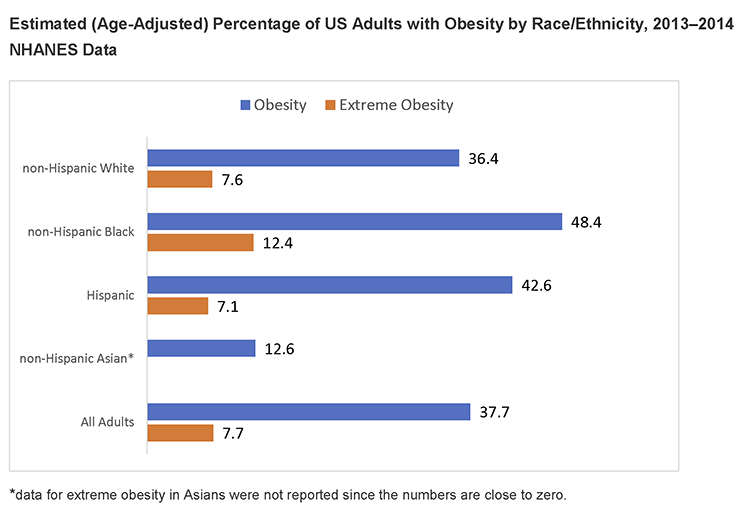Overweight and Obesity in the United States
According to data from the National Health and Nutrition Examination Survey (NHANES):
- About 1 in 3 adults were considered to be overweight.
- More than 2 in 3 adults were considered to be overweight or have obesity.
- More than 1 in 3 adults were considered to have obesity.
- About 1 in 13 adults were considered to have extreme obesity.
- About 1 in 6 children and adolescents ages 2 to 19 were considered to have obesity.
Causes and Health Consequences of Overweight and Obesity
Factors that may contribute to weight gain among adults and youth include genes, eating habits, physical inactivity, TV, computer, phone, and other screen time, sleep habits, medical conditions or medications, and where and how people live, including their access to healthy foods and safe places to be active.
Overweight and obesity are risk factors for many health problems such as type 2 diabetes, high blood pressure, joint problems, and gallstones, among other conditions.
For more information on the causes and health consequences of overweight and obesity, please visit NIDDK’s webpages on Understanding Adult Overweight and Obesity.
Adults
Estimated (Age-Adjusted) Percentage of US Adults with Overweight and Obesity by Sex, 2013–2014 NHANES Data
| All (Men and Women) | Men | Women | |
|---|---|---|---|
| Overweight or Obesity | 70.2 | 73.7 | 66.9 |
| Overweight | 32.5 | 38.7 | 26.5 |
| Obesity (including extreme obesity) | 37.7 | 35 | 40.4 |
| Extreme obesity | 7.7 | 5.5 | 9.9 |
As shown in the above table:
- More than 2 in 3 adults (70.2 percent) were considered to be overweight or have obesity
- About 1 in 3 adults (32.5 percent) were considered to be overweight
- More than 1 in 3 adults (37.7 percent) were considered to have obesity
- About 1 in 13 adults (7.7 percent) were considered to have extreme obesity
- More than 1 in 3 (38.7 percent) of men, and about 1 in 4 (26.5 percent) of women were considered to be overweight
- Obesity was higher in women (about 40 percent) than men (35 percent)
- Extreme obesity was higher in women (9.9 percent) than men (5.5 percent)
- Almost 3 in 4 men (73.7 percent) were considered to be overweight or have obesity; and about 2 in 3 women (66.9) were considered to be overweight or have obesity.

As shown in the above bar graph:
- Among non-Hispanic white adults, more than 1 in 3 (36.4 percent) were considered to have obesity, and about 1 in 13 (7.6 percent) were considered to have extreme obesity.
- Among non-Hispanic black adults, almost half (48.4 percent) were considered to have obesity, and about 1 in 8 (12.4 percent) were considered to have extreme obesity.
- Among Hispanic adults, about 1 in 2 (42.6 percent) were considered to have obesity, and about 1 in 14 (7.1 percent) were considered to have extreme obesity.
- Among non-Hispanic Asian adults, about 1 in 8 (12.6 percent) were considered to have obesity.
Candela Citations
- Prevalence of Overweight and Obesity. Authored by: National Institute of Diabetes and Digestive and Kidney Diseases. Provided by: National Institutes of Health. Located at: https://www.niddk.nih.gov/health-information/health-statistics/Pages/overweight-obesity-statistics.aspx. License: Public Domain: No Known Copyright